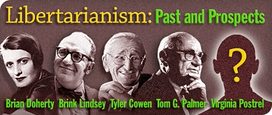Much of the current confusion about libertarianism’s future, and many of the deepest conflicts within libertarian circles today, can be chalked up to this fact: the world didn’t come to an end.
As Brian’s wonderful book makes vividly clear, the modern libertarian movement emerged as a prophecy of doom. Libertarians held vital knowledge about how the world works and how, consequently, societies should be ordered — yet the larger world had turned its back on this knowledge. Accordingly, the world was heading for ruin. Thus Hayek warned of the road to serfdom. Thus Mises argued that there is ultimately only the choice between laissez faire and socialism, and that all Third Ways are unsustainable makeshifts. And thus Rand made her magnum opus an apocalyptic fantasy about the consequences of abandoning individualism.
The apocalyptic mood at the heart of modern libertarianism had important consequences for the movement’s dominant intellectual style. If you think the world is coming to an end, you don’t mince words. You don’t seek compromises with the agents of destruction. Instead you state, as clearly and forcefully as you can, those neglected truths that alone can stave off disaster. And, in pulling together a “remnant” that can stick it out through the coming dark ages, you emphasize purity of commitment over all else.
During the fifties and early sixties, the heyday of American managerial liberalism, the libertarians’ dire warnings were dismissed by those in the know as so much crankish paranoia. But then came urban riots, Vietnam, Watergate, stagflation, and gas lines — and suddenly libertarianism didn’t seem so crazy anymore. As someone who came of age in the seventies, I can assure you that it really did feel like the world was falling apart. The libertarian moment had arrived.
But then a funny thing happened. Politicians put a number of libertarian reforms into effect — not nearly as many as libertarians might have hoped, but enough to trigger the quarter-century boom that has followed the brutal recession of 1982. Big Government remained, but the apocalypse never came. It turns out that even a relatively free economy is so immensely productive that it can carry a heavy deadweight load and still make impressive progress.
So now what? Now, if libertarians are to be as influential in the next generation as they were in the last, they have to adapt to current circumstances. They have to recognize that incremental progress is the only kind of progress that’s available. They have to understand that compromise can be a path to progress. They have to forget about weeding out heretics and focus on winning converts — which means engaging and making common cause with those of differing viewpoints. In short, they have to be post-apocalyptic libertarians.

